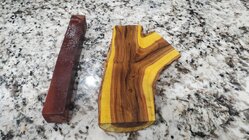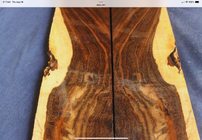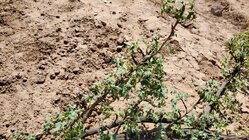-
December 2025 Turning Challenge: Single Tree! (click here for details) -
Congratulations to Bob Henrickson, People's Choice in the November 2025 Turning Challenge (click here for details) -
Congratulations to Guillaume Fontaine for "Old Tea Pot" being selected as Turning of the Week for December 15, 2025 (click here for details) -
Welcome new registering member. Your username must be your real First and Last name (for example: John Doe). "Screen names" and "handles" are not allowed and your registration will be deleted if you don't use your real name. Also, do not use all caps nor all lower case.
You are using an out of date browser. It may not display this or other websites correctly.
You should upgrade or use an alternative browser.
You should upgrade or use an alternative browser.
Anyone familiar with this wood?
- Thread starter Wyatt Holm
- Start date
Mark Hepburn
Artist & Chef
To me it looks like desert ironwood but I’m no expert
Odie
Panning for Montana gold, with Betsy, the mule!
To me it looks like desert ironwood but I’m no expert
That would have been my guess as well.
Whatever it is......if done right, it'll be extraordinarily beautiful!
=o=
I was wondering if it's desert ironwood. Does it usually have bright yellow sapwood?
Mark Hepburn
Artist & Chef
It can but don’t know if that is a common featureI was wondering if it's desert ironwood. Does it usually have bright yellow sapwood?
No bright yellow on any of this desert ironwood. https://www.cookwoods.com/products/desert-ironwood-bowl-blank-6-x-6-x-2
My guess is Cocobolo Rosewood
My guess is Cocobolo Rosewood
Attachments
Last edited:
Mark Hepburn
Artist & Chef
Here’s more information from the wood database:
 www.wood-database.com
www.wood-database.com
 www.wood-database.com
www.wood-database.com
Desert Ironwood | The Wood Database (Hardwood)
Cocobolo | The Wood Database (Hardwood)
This is a shrub growing in Northern Arizona. The pen blank is for size reference.
View attachment 78485
I have a variety of cocobolo wood and that piece is possible but doesn't look enough like it. But wood can be highly variable and difficult to tell from such a photo of side grain. Most of my cocobolo, but not all, has more color (orange, red, yellow etc). What I have was evidently cut from big trees and has no sapwood so I have to reference there. I've never seen any from a branch that tiny. Does that piece have sealer on it biasing the color?
But for me the most distinctive quick identifier is the smell. Smell it once and you can't forget. Saw a bit o the bandsaw, sand or turn some. As the wood database mentions, the scent is a bit spicy, sweet - I like the scent.
Also, be careful, many people are quite sensitive to cocobolo - a bit of sawdust under a bandaid on the forearm is a good non-fatal rash test. We knew a guy who was so sensitive he refused to enter a classroom and use a lathe that cocobolo had been turned on.
But the best way to ID cocobolo (and many species) is to shave a spot on the endgrain of a small sample with a single-edged razor blade and look at it with a 10x magnifier (I use a low-power stereo microscope). The picture at the bottom of the page on the Wood Database article doesn't do it justice - what I always see is the pores packed with clear, hard, orangish resin. In my experience, if the heartwood pores are not filled with this resin it's not cocobolo, at least not mature cocobolo. (Section 7 of their article on wood identification gives the procedure to prepare and examine the end grain) Just a very small sample is needed. I usually cut a piece that shows about 1/2"x1/2" endgrain, at least several rings, long enough to hold onto easily (or glue it to a small flat stick)
A read of the Wood Database ID article is often helpful:
Wood Identification Guide | The Wood Database
Some of the end grain photos on the hobbithouseinc.com article are better but still not anything like seeing it with the eye in good light. However, the HobbitHouseInc is also the best resource I know of to show the INCREDIBLE variety in color, figure, face and side grain any species, both heartwood and sapwood, unfinished and finished, boards, turnings. I often suggest that website to impart a feel for how much variety can be in wood even from various trees of the same species.
Consider the provenance - where did it come from? What kinds of shrubs grow in that part of the country? Does Cocobolo grow in northern Arizona? Might be a clue.
And if not in a hurry, the US gov lab will ID a small sample for free - send it in the mail. Details at the bottom of the Wood Database ID article. We sent a sample there once to double check my own ID. (Besides the web sites, I have reference books - a recommended one is R. Bruce Hoadley's "Identifying Wood". I used my first copy so much the pages started falling out so I got another copy.
Of course, another factor is how important is knowing the species? One option is to just guess, write it on the wood, and who will know. (Except maybe wood ID fanatics!) BTW, I got started on the hobby of wood id many years ago when a show-and-tell bowl was passed around at the club. It was marked "Cherry" on the bottom. Even without a hand lens it was obviously strongly ring-porous, definitely not cherry.
Edit: added some details I forgot.
JKJ
Last edited:
Jim McLain
Artist
Northern Arizona may be out of its range but could it be Agarita? Here in New Mexico it has that bright yellow sapwood. Unfortunately it does not keep its color.
My best guess is Fremont barberry (Berberis fremontii, formerly Mahonia fremontii). All barberry species have bright yellow wood, but the location and the darker heartwood make this my best guess.
Any pictures of the whole shrub, leaves, fruit, etc.?
Any pictures of the whole shrub, leaves, fruit, etc.?
Hit it with a blacklight. This Wood DB article says desert iron wood has faint streaks under blacklight. Apparently cocobolo does not fluoresce at all.
Mark Hepburn
Artist & Chef
Ouch! I've got a bunch of pen blanks of ironwood. Time to sell...I found this picture on the net for Arizona Desert Ironwood. The width was 3 - 3.5 inches by 0.32” by 12”. Just to make you feel good, asking price was $70 which works out to around $420/BF.
Through experience, I found that the 365nm UV light works the best. However, some sellers are not reliable and sell cheap UV lights that are closer to 400nm and negate the usefulness for wood ID. For wood ID, better to pay more and get good quality. I posted this beforeL at 365nm this is an example of fluorescence in two species, redheart and locust.Hit it with a blacklight. This Wood DB article says desert iron wood has faint streaks under blacklight. Apparently cocobolo does not fluoresce at all.
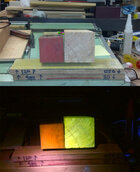
Maybe I'll try the UV light on the small piece of desert ironwood I have.
JKJ
Mark Hepburn
Artist & Chef
John, I'm sure we'd all like to hear your results if you do.Through experience, I found that the 365nm UV light works the best. However, some sellers are not reliable and sell cheap UV lights that are closer to 400nm and negate the usefulness for wood ID. For wood ID, better to pay more and get good quality. I posted this beforeL at 365nm this is an example of fluorescence in two species, redheart and locust.
View attachment 78509
Maybe I'll try the UV light on the small piece of desert ironwood I have.
JKJ
Some other interesting things to do with a UV light:
Walk through the woods at night and see how many Kentucky flat millipede are near. Around here I almost always see a bunch within 10' of anywhere. The orange bands fluoresce bright green.
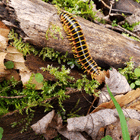
Look for fungi, many fluoresce.
Find lost things. I've also used a powerful UV light to find things I've dropped in fields and woods. (I like to wrap a strip of orange gaffers tape around small things I tend to misplace in the daytime - the tape glows brightly at night with UV!
Find eggs: Once a nighttime walks I noticed a bright red light from under some bushes. It turned out to be a nest of guinea eggs. Guineas are notoriously secretive about where they create their nests.
Some experimentation revealed that brown eggs of all types (guinea, peafowl, chicken) fluoresce bright red but the red slowly fades with time. I suspect it's a coating on the egg which oxidizes or fades with moisture but I haven't done a careful experiment.
The usefulness to me is when I find a nest I usually rob some of the eggs to incubate but leave a few so the bird will continue to lay. (They can't count) I pick up the brightest red eggs and leave the older ones. The freshest are more likely to hatch healthy chicks. (I sometimes also leave a few turned wooden guinea eggs as decoys.)
An example of the fluorescence with a freshly laid peafowl egg:
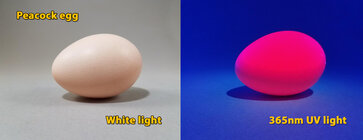
OK, this is a test of how far off topic I can get without getting ejected from the forum!
JKJ
Walk through the woods at night and see how many Kentucky flat millipede are near. Around here I almost always see a bunch within 10' of anywhere. The orange bands fluoresce bright green.

Look for fungi, many fluoresce.
Find lost things. I've also used a powerful UV light to find things I've dropped in fields and woods. (I like to wrap a strip of orange gaffers tape around small things I tend to misplace in the daytime - the tape glows brightly at night with UV!
Find eggs: Once a nighttime walks I noticed a bright red light from under some bushes. It turned out to be a nest of guinea eggs. Guineas are notoriously secretive about where they create their nests.
Some experimentation revealed that brown eggs of all types (guinea, peafowl, chicken) fluoresce bright red but the red slowly fades with time. I suspect it's a coating on the egg which oxidizes or fades with moisture but I haven't done a careful experiment.
The usefulness to me is when I find a nest I usually rob some of the eggs to incubate but leave a few so the bird will continue to lay. (They can't count) I pick up the brightest red eggs and leave the older ones. The freshest are more likely to hatch healthy chicks. (I sometimes also leave a few turned wooden guinea eggs as decoys.)
An example of the fluorescence with a freshly laid peafowl egg:

OK, this is a test of how far off topic I can get without getting ejected from the forum!
JKJ
Mark Hepburn
Artist & Chef
Wait, birds can’t count?!Some other interesting things to do with a UV light:
Walk through the woods at night and see how many Kentucky flat millipede are near. Around here I almost always see a bunch within 10' of anywhere. The orange bands fluoresce bright green.
View attachment 78512
Look for fungi, many fluoresce.
Find lost things. I've also used a powerful UV light to find things I've dropped in fields and woods. (I like to wrap a strip of orange gaffers tape around small things I tend to misplace in the daytime - the tape glows brightly at night with UV!
Find eggs: Once a nighttime walks I noticed a bright red light from under some bushes. It turned out to be a nest of guinea eggs. Guineas are notoriously secretive about where they create their nests.
Some experimentation revealed that brown eggs of all types (guinea, peafowl, chicken) fluoresce bright red but the red slowly fades with time. I suspect it's a coating on the egg which oxidizes or fades with moisture but I haven't done a careful experiment.
The usefulness to me is when I find a nest I usually rob some of the eggs to incubate but leave a few so the bird will continue to lay. (They can't count) I pick up the brightest red eggs and leave the older ones. The freshest are more likely to hatch healthy chicks. (I sometimes also leave a few turned wooden guinea eggs as decoys.)
An example of the fluorescence with a freshly laid peafowl egg:
View attachment 78511
OK, this is a test of how far off topic I can get without getting ejected from the forum!
JKJ
I don't know about all birds. Guinea fowl are the dumbest birds ever, even dumber than turkeys.
One will be on one side of a fence and will run up and down and up and down trying to get through - listen, YOU CAN FLY! I watched one fly through the woods from up the hill near my house, over the shop, and across 200' of field.
They can't even keep up with their babies. I kept an eye on one nest and the mama hatched 8 chicks. When she led them out of the brush 2 got lost and she didn't care "keep up or too bad."
Eventually there was only one left from that brood. Before it could fly even 4 feet up the mother decided to fly high in a tree to roost every night. The chick tried in vain to get up the tree, running and jumping and falling over and over. I couldn't catch it so it went off somewhere for the night. Never saw it again after the second night.
Guineas are entertaining though. And eat bugs and ticks all day. A friend in Georgia said she saw her's running around carrying snacks of baby copperhead snakes.
They are good to eat, all dark meat. Guinea is on the menu at some of the better restaurants in Italy.
A pied guinea hatching in my shop, and a small flock of French pearl guineas of various ages. How many do you want? 10? 20?
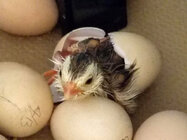
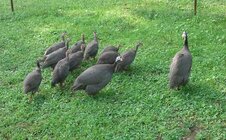
Well known woodturner, demonstrator, and teacher Frank Penta kept guineas for years until a fox got into his cages and killed every one. All mine are free-range except the very young.
Hawks are notorious for picking them off, but for some reason they never bother ours. A great horned owl is a different story. This one grabbed two the same night from about 30' up in the same roosting tree. It was quite unhappy with it's new temporary accommodations.
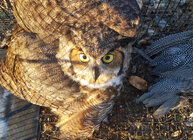
JKJ
One will be on one side of a fence and will run up and down and up and down trying to get through - listen, YOU CAN FLY! I watched one fly through the woods from up the hill near my house, over the shop, and across 200' of field.
They can't even keep up with their babies. I kept an eye on one nest and the mama hatched 8 chicks. When she led them out of the brush 2 got lost and she didn't care "keep up or too bad."
Eventually there was only one left from that brood. Before it could fly even 4 feet up the mother decided to fly high in a tree to roost every night. The chick tried in vain to get up the tree, running and jumping and falling over and over. I couldn't catch it so it went off somewhere for the night. Never saw it again after the second night.
Guineas are entertaining though. And eat bugs and ticks all day. A friend in Georgia said she saw her's running around carrying snacks of baby copperhead snakes.
They are good to eat, all dark meat. Guinea is on the menu at some of the better restaurants in Italy.
A pied guinea hatching in my shop, and a small flock of French pearl guineas of various ages. How many do you want? 10? 20?


Well known woodturner, demonstrator, and teacher Frank Penta kept guineas for years until a fox got into his cages and killed every one. All mine are free-range except the very young.
Hawks are notorious for picking them off, but for some reason they never bother ours. A great horned owl is a different story. This one grabbed two the same night from about 30' up in the same roosting tree. It was quite unhappy with it's new temporary accommodations.

JKJ
Leaves? I would mostly agree with Sonoran desert ironwood, but I have a few slices of mesquite with similar characteristics and nice gold sapwood like that.This is a shrub growing in Northern Arizona. The pen blank is for size reference.
View attachment 78485
I will try to get some pictures of the leaves. So far according to my wood identification books it is not desert ironwood. The bark doesn't match.
Beat me to it. Interesting Heartwood, it has to get really big to get that large of a branch.So here's a picture of the leaves. A search tells me it is Fremont Barberry
I believe it is Agarita. If that's another name for Fremont BarberryNorthern Arizona may be out of its range but could it be Agarita? Here in New Mexico it has that bright yellow sapwood. Unfortunately it does not keep its color.
Hawks are notorious for picking them off, but for some reason they never bother ours. A great horned owl is a different story. This one grabbed two the same night from about 30' up in the same roosting tree. It was quite unhappy with it's new temporary accommodations.
View attachment 78517
JKJ
Great horned owls will kill indiscriminately. Sometimes they pull all the heads off foul and just leave them lying there. They might eat one, but they'll kill a lot more.

